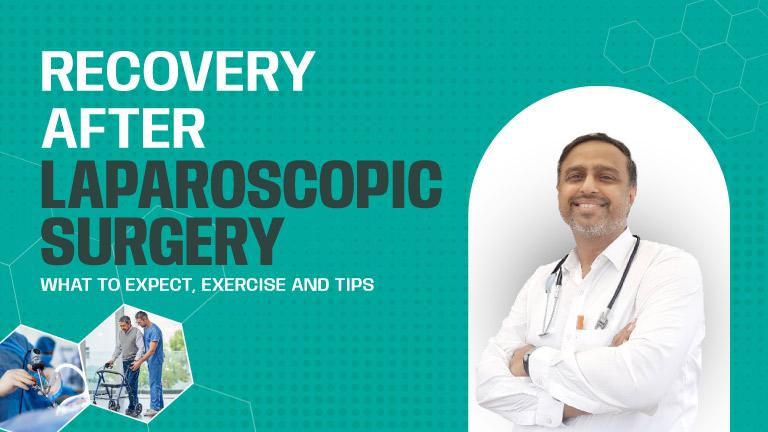How long is the recovery time from Laparoscopic surgery?
The recovery duration after laparoscopic gallbladder removal surgery can differ from individual to individual, influenced by factors such as overall well-being, age, the complexity of the surgery, and adherence to post-operative instructions from your physician. Nevertheless, outlined below is a general overview of the recovery timeline that a majority of patients can anticipate:
Hospital Stay: The majority of laparoscopic gallbladder removal procedures are conducted as outpatient surgeries, allowing you to return home either on the same day or the day following the surgery.
Return to Regular Activities: While you may be able to resume light activities within a few days to a week, it’s advisable to abstain from rigorous tasks, heavy lifting, and intense exercises for around 4 to 6 weeks.
Return to Work: If your job involves minimal physical exertion, you could potentially get back to work within one to two weeks. However, for occupations demanding physical labor, the recovery period might extend to 4 to 6 weeks.
Complete Recovery: Many individuals notice a significant improvement in their condition within a week or two post-surgery. Nevertheless, it could take a few weeks to a couple of months to achieve a full recovery and feel entirely back to normal, capable of engaging in all regular activities without experiencing discomfort.
What can be expected at home during the recovery period?
After undergoing laparoscopic surgery, your experience at home during the recovery period can vary depending on the type of surgery, your health, and the specific instructions given by your surgeon. However, here are some general expectations that you can expect at home after laparoscopic surgery.
- Pain and Discomfort
- Incision Care
- Rest and Activity
- Dietary Guidelines
- Hydration
- Medications
- Avoid Heavy Lifting and Straining
- Follow-Up Appointments
- Driving Restrictions
- Gradual Resumption of Activities
Exercise to try at home after Laparoscopic surgery
After laparoscopic surgery, it’s important to engage in gentle exercises that promote circulation, aid in healing, and prevent complications. Here are some safe and effective exercises you can do at home during your recovery post-laparoscopic surgery:
1. Deep Breathing Exercises:
- Sit comfortably and take slow, deep breaths, expanding your lungs fully.
- Hold the breath for a few seconds before exhaling slowly.
- Repeat this several times throughout the day.
2. Ankle Pumps and Circles: While lying down, gently move your ankles up and down, then in circular motions. This helps improve blood circulation and prevent blood clots.
3. Leg Raises
- Lie on your back and
- slowly lift one leg off the ground while keeping the knee straight.
- Hold for a few seconds, and then lower it down.
- Repeat with the other leg.
4. Glute Squeezes: While sitting or lying down, contract your glute muscles (buttocks) and hold for a few seconds before releasing. This exercise helps maintain muscle tone and circulation.
5. Seated Marching: Sit on a chair and lift one knee towards your chest, then lower it down. Alternate legs in a marching motion. This exercise helps improve circulation and leg mobility.
6. Walking: As you progress in your recovery, start with short walks around your home and gradually increase the duration and distance. Walking improves circulation, aids digestion, and supports overall healing.
Healthy Tips to Follow Post-Laparoscopic Surgery
Certainly, here are some healthy tips to follow post-laparoscopic surgery to aid in a smooth recovery and promote overall well-being:
- Adhere strictly to your healthcare provider’s post-operative instructions, including medication schedules, wound care, and activity restrictions.
- Drink plenty of water throughout the day to aid in digestion, prevent constipation, and promote healing.
- Focus on a balanced diet rich in whole foods, including lean proteins, fruits, vegetables, whole grains, and more.
- Opt for smaller, more frequent meals to avoid overloading your digestive system and maintain stable energy levels.
- Avoid heavy and spicy foods initially, as they can be harder to digest and may cause discomfort.
- Pay attention to your body’s signals. Rest when needed, and avoid activities that cause pain or discomfort.
- Avoid alcohol and tobacco products, as they can impair healing and interfere with your recovery.
- Practice deep breathing and relaxation to reduce stress, improve lung function, and support healing.
- Aim to maintain a healthy weight, as excess weight can strain your incision sites and delay recovery.
- Attend all scheduled follow-up appointments and monitor your progress or any concerns.






